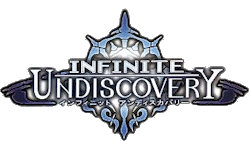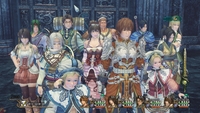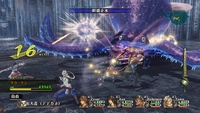|
|

|
PLATFORM
|
Xbox 360
|
BATTLE SYSTEM
|

|
INTERACTION
|

|
ORIGINALITY
|

|
STORY
|

|
MUSIC & SOUND
|

|
VISUALS
|

|
CHALLENGE
|
Adjustable
|
COMPLETION TIME
|
Less than 20 Hours
|
|
OVERALL

|
+ Interesting Combat
+ Outsanding Music
+ Unique Setting
- Unnecesary Features
- Horrible Animation
|
Click here for scoring definitions
|
|
|
Tri-Ace isn't a company new to the world of role-playing games. In fact, they have quite an established lineage, going all the way back to the original Star Ocean title for the Super Famicom in 1996. Needless to say, when the company announced Infinite Undiscovery—both a new title and intellectual property—in 2006, many fans of their work were hopeful of the possibilities. Radiata Stories had been released just the previous year, and to reasonable critical acclaim no less, so the idea of another new title from both the same company and team was promising, to say the least.
The story revolves around a boy named Capell and the misadventures he seemingly fumbles into. Soon after the beginning of the game, Capell is pulled into a band of freedom fighters trying to rid of the world of the Order of Chains. Apparently this Order has chained the moon to the planet and wants to use its power to some evil ends. The moon in this world isn't simply a heavenly body; it's home to Veros, the Crimson God. See, everything in the world of Infinite Undiscovery is tied to the Moon, from religious practices to political structuring, so an action that is basically tying down the home of God is sure to spur up discontent. As the story unfolds, Capell joins up with a wide assortment of characters that range from likable to incredibly annoying. Some characters seem dynamic and lovable, while others test the player's willpower against stabbing them in their glossy, video-game eyes. Though the story is based upon an interesting premise, the pace at which the story develops will likely deter many from playing too far, as it is at least halfway into the game when the story picks up.
Combat also brings many interesting aspects in its presentation, including the not-entirely-original aspect of it occuring completely in real time. It's a little bit difficult to explain without a proper visual explanation, but the overall feel to the game seems to be very reminiscent of a MMO. The player never stumbles into random battles. Instead, they can see every monster that awaits ahead. After engaging in combat, the fighting occurs right on the world map in real-time. However, rather than relying on the turn-based fighting that is usually associated with most traditional RPGs, Infinite Undiscovery's battles are completely action-oriented. Not only is combat action-oriented, there is absolutely no way to pause combat when shifting around menus, making the use of items fairly prohibitive.
 The motley cast of characters
The motley cast of characters
|
|
These limitations may seem daunting when considering that a party consists of four members, but Infinite Undiscovery tries to simplify the complexity of such situations by allowing Capell to be the only controllable character in combat. This lack of control is probably the battle system's biggest problem, because as a result, it attempts to shoe-horn in ways to have some influence over the party. Some tools of this influence are simple and work quite well. For example, there is a 'Heal Me' command that informs the party to either heal themselves or the most needy party member. It's mapped to one of the face buttons of the controller, so during a time of need, one simply needs to spam the button. Other forms of influence, however, feel far more clumsy. Anytime during the game the player can 'connect' with another party member. When said connection is activated, certain predefinable skills from that character become mapped to the controller. These can be either skills that the character may normally use in combat or skills that require both Capell and the other character to use them cooperatively. While these connections could have added a great deal of depth to the combat, the actual practicality of their use never seems to become apparent in a combat setting. This is compounded by the fact that when connection skills become mapped to the controller, they cover up the previously mentioned "Heal Me" command that is usually completely necessary.
There are redeeming features to the combat, though. There can be some awkwardness to the amount of options that the game throws at the player during fighting, but more often than not, the best course of action is to play as simply as possible. If the player allows the AI to take control of the party members and play the title more like an action game, in other words going around whacking guys at leisure, more often than not the party will fall in line and do appropriate things as necessary. In fact, someone could probably play the entire game this way granted the player always had their handy "Heal Me" button close by. Combat can even be incredibly fun when played this way. On the other hand, it's sad that gamers have to resort to such lengths when the combat, by design, has so many elements that really didn't seem necessary. However, the core of the combat design is different enough to really appreciate what it was trying to do. If nothing else, the combat system established a solid basis for possible sequels in the years to come.
 Watch out for the giant octopus!
Watch out for the giant octopus!
|
|
Visually, Infinite Undiscovery is very much a disappointment. While the combat was quite fun at times, the game is really quite a mess visually. Outside of screenshots and some cinematic sequences, the public had really seen very little of the game in motion up until release. In stills, the game looks fine, but when things start to move, something just doesn't seem quite right. Character animations can be overly expressed or highly stiff, and shadows jump around and flicker. While it doesn't have the worst cinematic sequences seen in an RPG, it is very reminiscent of a mediocre, last-gen RPG. Things really seem to have needed another year or so of polishing before being shipped out.
Thankfully, the music of the game helps make up for the shortcomings of the visuals. Though the music is definitely not the greatest experience within a video game, there is a level of integration between music and environment that really surpassed all expectations. In certain locations in game, the music is incredibly subtle. In fact, it's hardly more than a backdrop to the overall environment, but the music is always very appropriately matched within its environment. Towns that seem quiet and stoic have amazingly simple music that match it, but the package of both visuals and audio create a narrative that makes the location feel quite tangible. Instead of the music competing with the visuals as it can do in many games, the music of Infinite Undiscovery worked in cooperation with the visuals, providing a more complete experience.
In the end, Infinite Undiscovery seems to be a game that could have used a bit more work. By no means is it a bad game. In fact, it can be quite enjoyable, but the different aspects of the game present a very mixed bag when it comes to quality. There will be some players that will genuinely love the title for the overall package it brings to the table. Likewise, there will probably be a considerable amount of people who find the title to be completely unenjoyable. The contrast of both the good and bad elements is incredibly high and may very well be completely overlooked by most who play. Even still, it is probably still worth a play, even if not worth a purchase. The compilation of concepts that Infinite Undiscovery presents is unique enough that a niche group of fans will not only enjoy, but genuinely love it.
Review Archives
|









